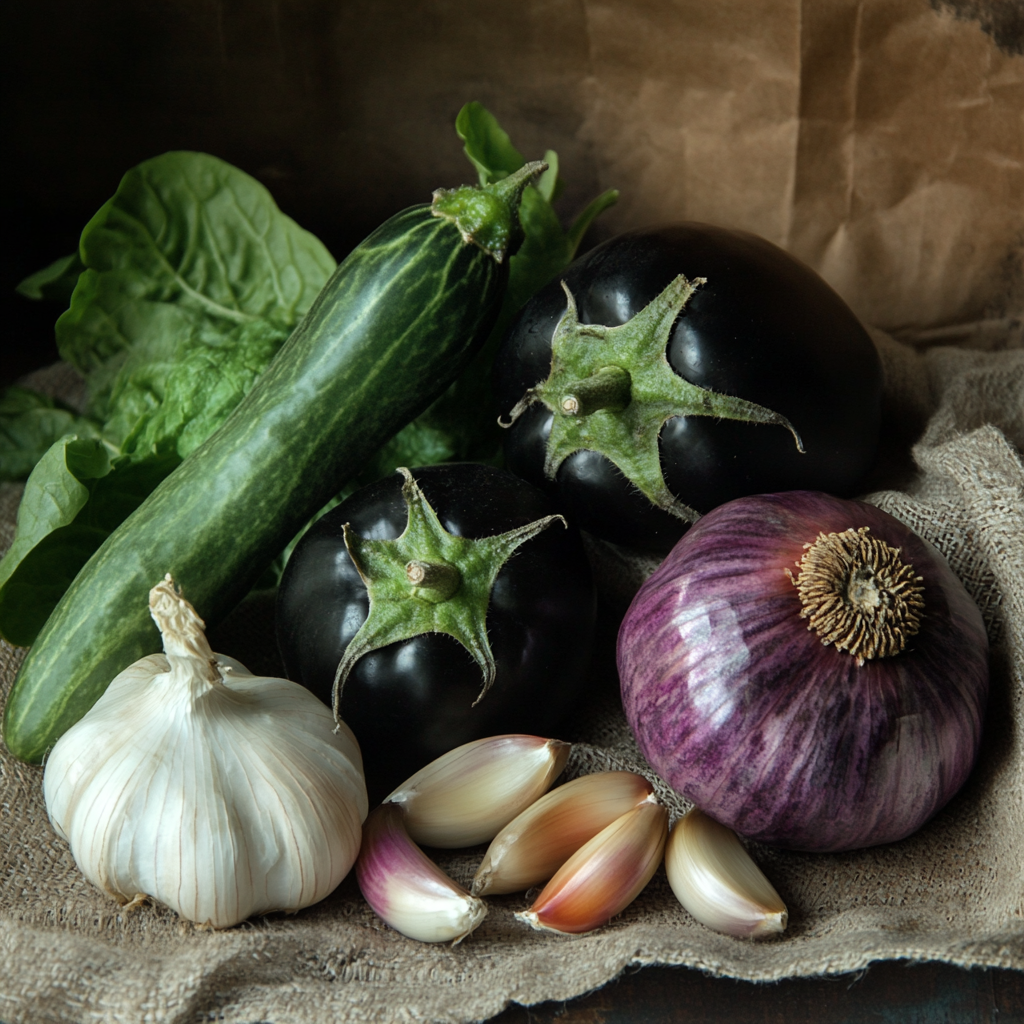Understanding Nightshade Vegetables and Garlic: A Comprehensive Guide
Nightshade vegetables and garlic, staples in many diets, offer unique flavors and health benefits. Comparing nightshade vegetables and garlic: differences in plant families reveal diverse impacts on health. Yet, they belong to different plant families, each with distinct characteristics. This article delves into their differences, culinary uses, health impacts, and the myths surrounding them.
Key Takeaways
- Nightshades include tomatoes, eggplant, potatoes, and peppers; garlic belongs to the Allium family.
- Nightshades contain alkaloids like solanine; garlic is rich in sulfur compounds.
- Both have diverse culinary uses and health benefits but differ in chemical composition and potential health impacts.
Introduction to Nightshade Vegetables and Garlic
Nightshade vegetables, part of the Solanaceae family, include popular foods like tomatoes, eggplant, potatoes, peppers, and sweet potato. They are known for their alkaloid content, which can be controversial in terms of health impacts, particularly for those with nightshade intolerance. On the other hand, garlic, a member of the Allium family, is widely recognized for its unique flavor and health benefits. This contrast sets the stage for an intriguing comparison.
Basic Classification
| Vegetable Type | Family | Notable Members |
|---|---|---|
| Nightshades | Solanaceae | Tomatoes, Eggplant, Potatoes, Peppers |
| Garlic | Allium | Garlic, Onions, Leeks, Chives |
Nightshade Vegetables: Types and Characteristics
Nightshade Vegetable Characteristics
| Vegetable | Characteristics | Common Uses |
|---|---|---|
| Tomato | Fruity, acidic | Salads, sauces |
| Eggplant | Spongy, absorbent | Grilled, baked dishes |
| Potato | Starchy, versatile | Boiled, fried, baked |
| Pepper | Spicy to sweet | Raw, cooked, spices |
Nightshade vegetables are unique due to their alkaloid compounds, like solanine, which can be toxic in high concentrations, leading to potential nightshade allergy in sensitive individuals. However, the levels found in commonly consumed nightshades are generally safe. These vegetables are also rich in nutrients and form a significant part of many diets worldwide.
For more on nightshade vegetables and health considerations, visit WebMD’s detailed guide.
Garlic: A Member of the Allium Family
Garlic, unlike nightshades, contains sulfur compounds that give it a distinctive flavor and aroma, contrasting with nightshade fruits like tomato and eggplant. It’s renowned for its health benefits, including anti-inflammatory and antioxidant properties.
| Benefit | Description |
|---|---|
| Anti-inflammatory | Reduces inflammation in the body |
| Antioxidant | Fights free radicals |
| Heart health | Improves cholesterol levels |
- Internal Link: Explore the health benefits and nutritional value of garlic.
Comparison of Nightshades and Garlic
When comparing nightshades and garlic, the differences in their plant families, such as the cabbage family versus the nightshade family, and chemical compositions become apparent. Nightshades contain alkaloids that can impact health differently than the sulfur compounds found in garlic, affecting individuals with nightshade sensitivity and food allergies.
- Bold: Alkaloids in nightshades vs. sulfur compounds in garlic
- Impact: Nightshades may cause issues in sensitive individuals; garlic is generally beneficial.
This section’s depth reveals the complexities in their dietary roles and health effects. For an in-depth comparison, visit GarlicFact’s comprehensive guide.
Culinary Uses of Nightshades and Garlic
The culinary world greatly benefits from the versatility of both nightshade vegetables and garlic. They are used in a myriad of dishes across cultures, adding unique flavors and textures.
Culinary Uses
| Ingredient | Uses |
|---|---|
| Nightshades | Sauces, stews, salads, baked goods |
| Garlic | Seasoning, marinades, medicinal uses |
- Internal Link: Discover a variety of recipes incorporating garlic.
The Controversy Surrounding Nightshade Vegetables
Nightshade vegetables, including hot peppers and deadly nightshade, are often the subject of health debates. Some claim they cause inflammation and should be avoided by certain individuals, particularly those with autoimmune diseases or following an elimination diet. However, scientific evidence is mixed, and for most people, they are a nutritious part of a balanced diet.
Bullet Points
- Some believe nightshades can cause inflammation.
- Others argue their health benefits outweigh potential risks.
For a nuanced perspective, consider the Cleveland Clinic’s article on nightshades, available here.
Garlic: Exploring Its Medicinal Properties and Uses
Garlic is not just a culinary staple; it’s also known for its medicinal properties, offering nutritional value with vitamins c and k. Historically and in modern times, garlic has been used to treat various ailments, underscoring its importance beyond the kitchen.
Medicinal Uses of Garlic
| Use | Effect |
|---|---|
| Antimicrobial | Fights bacteria and viruses |
| Cardiovascular | Improves heart health |
| Immune System | Boosts immune response |
- Internal Link: Learn about garlic’s impact on worm life cycles, illustrating its diverse applications.
Conclusion
This section concludes the first part of our exploration into nightshade vegetables and garlic. We’ve examined their classifications, health benefits, culinary uses, and the controversies surrounding them. Stay tuned for Part 2, where we delve further into FAQs and additional insights.
Further Insights and Practical Information
FAQs About Nightshade Vegetables and Garlic
Q1: Are nightshade vegetables harmful to everyone?
- A1: Not necessarily. While they contain alkaloids, which can be problematic for some, they are safe and nutritious for most people.
Q2: Can eating garlic improve my health?
- A2: Yes, garlic is known for its health benefits, including anti-inflammatory and antioxidant properties.
Q3: Are tomatoes and potatoes related?
- A3: Yes, both are part of the nightshade family.
Dietary Considerations for Nightshade Vegetables and Garlic
Dietary Considerations
| Factor | Nightshades | Garlic |
|---|---|---|
| Allergies | Rare but possible | Rare |
| Digestive Health | May irritate in some cases | Generally beneficial |
| Inflammation | Controversial | Anti-inflammatory |
Discover more about the dietary considerations of nightshades at Cleveland Clinic’s health blog.
The Role of Nightshades and Garlic in Cultural Cuisines
Nightshades and garlic play significant roles in various cultural cuisines, such as tomato sauce and bell pepper in Italian dishes. They are not just food ingredients; they are integral to the culinary heritage and practices of many cultures.
Cultural Cuisine Highlights
| Culture | Nightshades | Garlic |
|---|---|---|
| Italian | Tomatoes in pasta sauces | Garlic in aglio e olio |
| Indian | Eggplant in baingan bharta | Garlic in curries |
| Mexican | Peppers in salsas | Garlic in mole |
Nutritional Profiles of Nightshades and Garlic
Both nightshades and garlic offer unique nutritional profiles, contributing to a balanced diet that includes vitamin a, chili pepper, and cayenne pepper.
Nutritional Profiles
| Nutrient | Nightshades | Garlic |
|---|---|---|
| Vitamins | A, C, E | B6, C |
| Minerals | Potassium, Iron | Calcium, Phosphorus |
| Phytochemicals | Lycopene, Capsaicin | Allicin |
- Internal Link: Explore the nutritional benefits of garlic.
The Evolution of Nightshades and Garlic in Agriculture
The cultivation and agricultural practices of nightshades and garlic have evolved over time, adapting to various climates, crop rotation practices, and farming techniques.
Agricultural Evolution of Nightshade Plants and Garlic
| Aspect | Nightshades | Garlic |
|---|---|---|
| Cultivation | Worldwide, diverse climates | Requires well-drained soil, similar to that needed for root vegetables and black pepper |
| Harvesting | Seasonal variations, especially in nightshade food items like the white potato and goji berries | Harvested in summer, often with other crops like broccoli and butternut squash |
Current Research on Nightshades and Garlic
Recent studies have focused on the potential vitamin C and vitamin K health benefits and risks associated with nightshade vegetables and garlic. Ongoing research aims to better understand their roles in human health, nutrition, and food sensitivity.
Final Thoughts
As we conclude this exploration into nightshade vegetables and garlic, it’s clear that both play unique and important roles in our diets and cultures. Understanding their differences, health impacts, and nutritional profiles can help us make informed dietary choices for our vegetable gardens and beyond.

